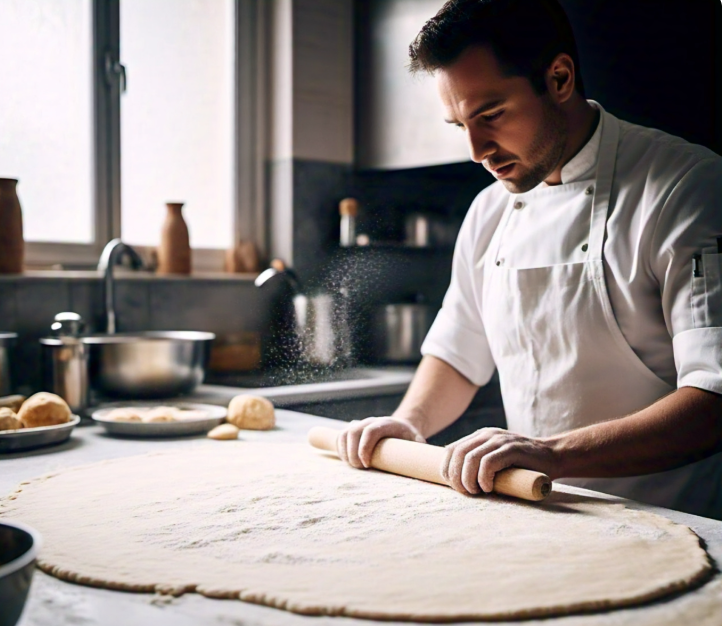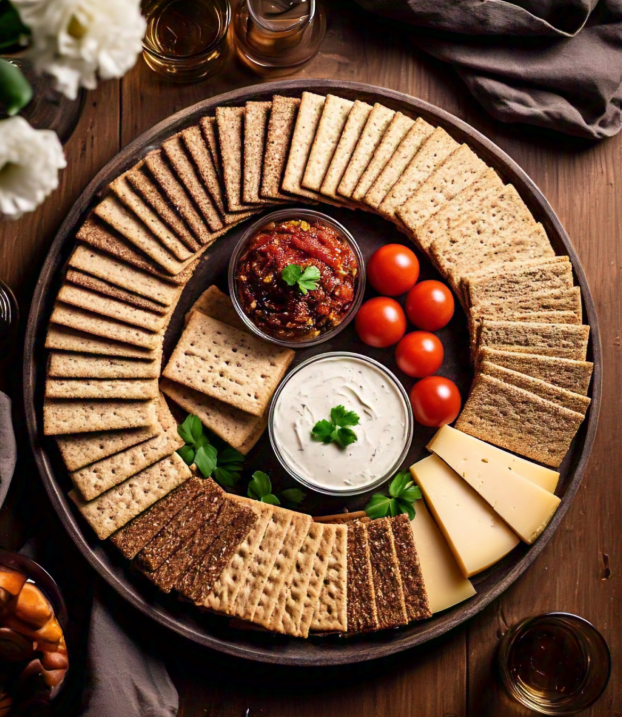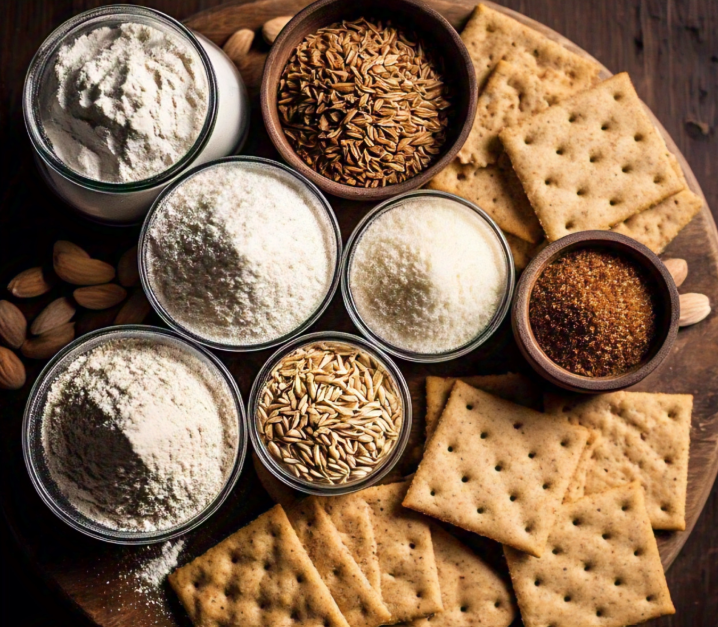Crackers are one of those delightful snacks that effortlessly blend flavor and function. They’re perfect as a standalone treat, an accompaniment to soups, or as the star of a cheese platter. But what truly makes a cracker irresistible? The answer lies in the flour. Yes, the humble flour that forms the foundation of every recipe plays a massive role in determining a cracker’s texture, flavor, and even how well it pairs with your favorite dips. So, let’s dive into the ultimate question: What flour is best for crackers?
Table of Contents
Understanding the Role of Flour in Crackers
Why Flour Matters in Cracker Baking
Think of flour as the backbone of your cracker. Without it, the dough wouldn’t come together, and the structure would crumble—quite literally. Flour provides the necessary proteins and starches that determine the cracker’s crispness, chewiness, or flakiness.
When you bite into a cracker, that satisfying crunch or delicate snap isn’t just magic—it’s chemistry. The flour, when combined with water and fat, forms gluten. Gluten is the elastic network that traps air, giving crackers their desired shape and texture. And the type of flour you choose, especially when aiming for the best flour for homemade crackers, can tweak these characteristics to perfection.
The Impact of Gluten on Cracker Texture
Speaking of gluten, it’s the silent hero (or villain, depending on your dietary needs). High-gluten flours, like bread flour, create robust, crunchy crackers that hold their shape well. Meanwhile, low-gluten or gluten-free flours result in tender, crumbly crackers. If you’ve ever wondered why some crackers feel like snapping twigs while others practically dissolve in your mouth, gluten is the answer.
For gluten-free alternatives, check out Gluten-Free Tiramisu: A Delightful Twist on a Classic Dessert.
Choosing the Right Flour for Desired Results
Your choice of flour boils down to what you want out of your crackers. Looking for a hearty, nutty flavor? Whole wheat flour might be your go-to. Prefer a lighter, more neutral taste? All-purpose flour will do the trick. When searching for the best flour for homemade crackers, the decision also hinges on dietary needs and the recipe you’re using.
Types of Flours Commonly Used for Crackers
All-Purpose Flour: A Versatile Choice
All-purpose flour lives up to its name—it works for almost everything, including crackers. Its moderate protein content ensures a balanced texture that’s not too tough nor too delicate. This flour is a great option for classic crackers with mild flavors that let toppings shine.
Whole Wheat Flour: Nutritious and Hearty
Want a cracker that packs a nutritional punch? Whole wheat flour is your answer. It’s loaded with fiber and nutrients, offering a hearty taste that pairs well with cheese spreads and savory dips. For the best flour for homemade crackers, whole wheat is a strong contender, though its coarse texture means you might need to blend it with a lighter flour for smoother results.
Rye Flour: A Bold and Distinctive Flavor
Craving something a little different? Rye flour delivers. With its earthy, tangy notes, it’s ideal for crackers with a personality. Rye flour pairs beautifully with robust flavors like smoked salmon or sharp cheddar. However, its low gluten content makes it less elastic, so a touch of all-purpose flour can help balance the dough.
Gluten-Free Flours: Meeting Dietary Needs
For those avoiding gluten, fear not—there’s an array of gluten-free options. Almond, chickpea, and rice flours can all create delicious crackers. These flours often require a binding agent, like xanthan gum, to mimic gluten’s effects. The result? A whole world of crackers that are just as tasty and versatile as their traditional counterparts.
Comparing Refined vs. Whole Grain Flours for Crackers
Benefits of Refined Flours in Crackers
Refined flours, such as all-purpose or pastry flour, are popular for a reason—they’re easy to work with and produce consistently smooth textures. When you use refined flour in crackers, the result is usually a light, crispy product with a neutral flavor that won’t overpower toppings or dips.
Refined flours also offer better dough elasticity, which is crucial when rolling out crackers to an even thickness. This uniformity ensures they bake evenly and develop that coveted crunch. However, the trade-off is in the nutritional department, as refined flours lose fiber and some nutrients during processing.
Advantages of Whole Grain Flours in Baking
If you’re looking for crackers with a robust flavor and added health benefits, whole grain flours are the way to go. These flours retain the bran and germ, packing them with fiber, vitamins, and minerals. The nutty, earthy taste of whole grain flour creates crackers that can stand alone as a snack without needing extra accompaniments, making them an excellent choice when selecting the best flour for homemade crackers.
Whole grain flours can, however, be trickier to work with. Their coarse texture may require additional water or a blending approach, combining them with refined flours to achieve the right balance of flavor and texture. But if health-conscious eating is a priority, whole grain flours are well worth the effort.
Specialty Flours for Unique Cracker Recipes
Almond Flour for Gluten-Free Crackers
Almond flour is a game-changer for gluten-free crackers and is often considered the best flour for homemade crackers. Its fine texture and subtly sweet, nutty flavor create crackers that feel gourmet. Not only is almond flour rich in healthy fats and protein, but it also delivers a delightful crumb that pairs beautifully with everything from creamy brie to spicy hummus.
However, because almond flour lacks gluten, it’s essential to include a binding agent like an egg or flaxseed meal in your dough. This ensures your crackers hold together and maintain their shape during baking.
Chickpea Flour for High-Protein Options
Chickpea flour, also known as gram or besan flour, is another superstar for cracker baking and one of the best flours for homemade crackers. It brings a distinct earthy flavor and a satisfying crunch, all while being naturally high in protein. Chickpea flour crackers are fantastic for a healthy snack option, especially when seasoned with spices like cumin, paprika, or garlic powder.
One thing to note: chickpea flour has a dense, slightly sticky texture when hydrated. So, you might need to combine it with lighter flours or roll the dough carefully to avoid overly thick crackers.
Spelt Flour for a Mild Nutty Flavor
For bakers who want a unique yet approachable flavor, spelt flour is a fantastic choice. This ancient grain boasts a mild nuttiness that adds complexity to crackers without overwhelming the palate. It’s slightly more forgiving than whole wheat flour but still brings a nutritional edge with higher fiber and mineral content.
Spelt flour crackers shine when paired with natural ingredients like honey, seeds, or herbs, offering a rustic charm that’s hard to resist.
Blending Flours for Custom Cracker Textures

Tips for Mixing Flours Successfully
Blending different flours is like creating your own symphony in the kitchen. Want a cracker that’s crunchy yet tender? Combine all-purpose flour with a touch of almond flour. Looking for a cracker with a hearty texture and a lighter finish? Mix whole wheat with spelt flour.
When blending flours, it’s essential to pay attention to hydration. Whole grain and nut-based flours tend to absorb more liquid than refined ones, so you may need to adjust your water or fat ratio to get the dough just right.
How Blended Flours Affect Baking Outcomes
Using blended flours not only changes the flavor profile but also impacts how your crackers bake. For instance, adding rye flour to an all-purpose flour base creates a denser cracker with a rich, earthy taste. On the other hand, incorporating almond flour can make crackers more tender and crumbly.
Experimenting with blends allows you to tailor your crackers to specific preferences or occasions. Whether you’re aiming for a crispy, airy cracker or one with a bit more bite, the possibilities are endless.
Factors to Consider When Choosing Cracker Flour
Dietary Restrictions and Preferences
Choosing the right flour for crackers often starts with considering who will enjoy them. Are you catering to someone with gluten intolerance or celiac disease? In that case, gluten-free options like almond or chickpea flour are essential.
For those seeking high-protein or low-carb options, nut-based flours like almond or coconut flour might be ideal. On the other hand, if health is a priority but gluten isn’t a concern, whole grain flours such as spelt or whole wheat can deliver both nutrition and flavor. By aligning your flour choice with dietary needs, you can find the best flour for homemade crackers and ensure everyone has a seat at the snacking table.
Flavor Profiles and Pairings
Not all crackers are created equal in taste. Some are designed to stand alone, while others play the role of a subtle backdrop to bold toppings. Flours like rye or chickpea lend themselves to distinctive, earthy flavors, making them ideal for standalone crackers.
For neutral or versatile crackers meant to complement cheeses, dips, or spreads, all-purpose or spelt flour works well. Imagine pairing a mildly sweet almond flour cracker with creamy brie or a tangy rye cracker with smoked salmon—the possibilities are endless.
Baking Techniques and Skill Levels
Your experience in the kitchen might also influence your flour selection. For beginners, starting with all-purpose flour is a safe choice—it’s predictable and forgiving. More experienced bakers, however, might enjoy the challenge of working with whole wheat or gluten-free flours, which can require more precise handling.
Additionally, the flour you choose can dictate your baking techniques. For instance, doughs made from almond flour may be more fragile, requiring careful rolling and cutting. Meanwhile, whole grain doughs might need extra hydration or resting time for the bran to soften and fully integrate into the mix.
Common Problems in Cracker Baking and Solutions
Why Do Crackers Turn Out Too Hard?
If your crackers feel more like teeth-chipping chips than light, crispy snacks, the culprit is likely overworking the dough or overbaking. Hard crackers often result from too much gluten development, which happens when dough is kneaded excessively.
Solution? Handle your dough gently. Mix it just until it comes together and roll it out evenly to avoid overly dense patches. And don’t forget to keep a close eye on baking times—pull them out when they’re golden, not brown.
How to Avoid Overly Crumbly Crackers
Crackers that fall apart at the slightest touch can be frustrating. This issue is common with low-gluten or gluten-free flours like almond or rice flour. Without gluten’s elasticity, the dough lacks the structure needed to hold its shape.
To fix this, add a binding agent like egg, flaxseed, or even a small amount of xanthan gum. These ingredients help mimic the stretchiness of gluten, creating a dough that’s easier to work with and crackers that hold together beautifully.
Fixing Bland or Unbalanced Flavors
Have you ever tasted a cracker that left you feeling… underwhelmed? Bland crackers are often the result of insufficient seasoning or relying solely on mild flours like all-purpose.
To amp up the flavor, don’t be shy with your seasonings. Add herbs, spices, or grated cheeses directly to the dough. If you’re working with a naturally bold flour like rye or chickpea, balance it with complementary ingredients, such as honey for sweetness or a touch of lemon zest for brightness.
Recipes Showcasing Different Flours for Crackers
Classic Cracker Recipe with All-Purpose Flour
For a timeless option, combine all-purpose flour, olive oil, water, and a pinch of salt. Roll the dough thin, sprinkle with sea salt or sesame seeds, and bake until golden. These crackers pair perfectly with soft cheeses or savory dips.
Whole Wheat and Herb Crackers Recipe
Take your health-conscious snacking to the next level with whole wheat flour. Mix the flour with olive oil, water, and your favorite herbs, such as rosemary or thyme. The result? A hearty, flavorful cracker that’s great on its own or with hummus.
Gluten-Free Almond Flour Cracker Recipe
For a gluten-free delight, almond flour steals the show. Combine it with an egg, olive oil, and your choice of seasoning. Roll the dough thin, cut into squares, and bake. These crackers are slightly sweet and pair wonderfully with nut butter or fresh fruit spreads.
Expert Tips for Perfect Crackers Every Time

Measuring Ingredients Accurately
Precision is key when it comes to crackers. Too much or too little of an ingredient can throw off the entire recipe. Use a kitchen scale for best results, especially when working with delicate flours like almond or chickpea.
Controlling Dough Moisture and Texture
The right dough consistency is critical. If it’s too dry, the crackers may crack during rolling; too wet, and they’ll stick to everything. Add water or flour incrementally, and feel the dough—it should be firm but pliable, like modeling clay.
Baking Times and Temperatures for Crispness
The difference between perfection and a burned batch is often a matter of minutes. Crackers bake quickly, so keep an eye on them. Bake at a high temperature (around 375°F or 190°C) for a short time to ensure a crisp, golden result without over-drying them.
Frequently Asked Questions about Cracker Flour
Can I Use Self-Rising Flour for Crackers?
Yes, but with a caveat. Self-rising flour contains baking powder and salt, which can make crackers puffier than traditional flat crackers. If you’re aiming for a more biscuit-like texture, self-rising flour works well. However, for thin, crispy crackers, it’s best to stick to all-purpose or other non-leavened flours.
If you decide to use self-rising flour, adjust the additional salt in your recipe to avoid overly salty crackers.
What’s the Best Gluten-Free Flour for Crackers?
The best gluten-free flour depends on your flavor and texture preferences. Almond flour is a top choice for its nutty flavor and crisp texture, while chickpea flour offers an earthy taste and added protein. Rice flour, on the other hand, is milder and creates a delicate cracker.
Experimenting with combinations, such as almond flour with a bit of tapioca starch, can yield even better results. Binding agents like xanthan gum or ground flaxseed are also crucial when using gluten-free flours to improve the dough’s workability.
Are Whole Grain Crackers Always Healthier?
Not necessarily. Whole grain crackers are richer in fiber and nutrients, which makes them a healthier option in terms of nutrition. However, the overall healthiness depends on the other ingredients in the recipe. Crackers loaded with added sugars, oils, or sodium can outweigh the benefits of whole grain flour.
For a truly healthy option, choose recipes that minimize processed ingredients and focus on wholesome, nutrient-dense add-ins like seeds, herbs, and healthy fats.
Can I Mix Different Flours in One Recipe?
Absolutely! Mixing flours is one of the best ways to customize your crackers. Combining flours like rye and all-purpose can balance bold flavors with a manageable texture. Gluten-free bakers often blend almond, rice, and tapioca flours to achieve better elasticity and consistency.
The key is to understand the properties of each flour and adjust liquids or binding agents accordingly. Start with small batches to test your combinations before scaling up.
Why Are My Crackers Not Crispy Enough?
Soft crackers are often a result of underbaking or overly thick dough. To ensure crispness, roll your dough as thin as possible—usually around 1/8 inch or thinner. Additionally, baking at a higher temperature for a shorter time helps remove moisture quickly, resulting in that perfect snap.
If your crackers still aren’t crispy, let them cool completely before storing them in an airtight container to avoid trapping residual moisture.
What Flours Are Best for Flavored Crackers?
Flavored crackers pair beautifully with specialty flours. For example, rye flour enhances savory flavors like garlic or smoked paprika. Whole wheat flour complements herb-based crackers, while almond flour is ideal for slightly sweet crackers with cinnamon or nutmeg. Choosing the best flour for homemade crackers ensures your flavors shine while creating the perfect texture.
For bold and spicy flavors, chickpea flour works wonders as it holds onto seasonings exceptionally well.
Conclusion: Selecting the Ideal Flour for Crackers
Choosing the best flour for crackers depends on your goals—whether it’s achieving a classic crispy texture, accommodating dietary restrictions, or crafting something bold and unique. All-purpose flour is versatile and reliable for most recipes, while whole grain and specialty flours open doors to a world of flavors and textures.
Remember, cracker-making is as much about experimenting as it is about precision. Blend flours, play with seasonings, and don’t be afraid to make mistakes. The beauty of homemade crackers lies in their uniqueness, and with the right flour, you’ll have a perfect batch every time.
Learn how to pair your crackers with the best Ultimate Guide to Homemade Crackers Recipe for tips on toppings and flavor combinations.

